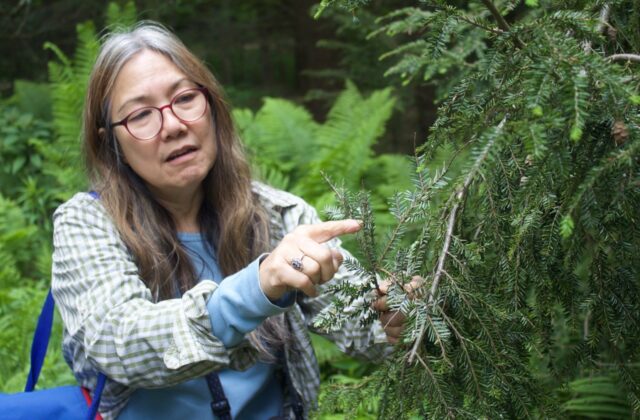Local Landowners Rally to Protect Hemlocks
It’s Only Natural
Text By Susannah Wood
Photo by Wiley Wood
On a cool afternoon at the beginning of June, a dozen or so volunteers gathered around a short woman sporting hiking gear, several fanny packs and a long stave with a hook on the end. Carole Cheah of the Connecticut State Agricultural Experiment Station was ready for business. She was there to coordinate the release of 27 colonies of Sasajiscymnus tsugae, a tiny black ladybeetle, around the shores of Tobey Pond in hopes of saving the beautiful stands of eastern hemlock there.
Hemlocks across the eastern United States are under attack by the hemlock woolly adelgid (HWA), an invasive insect pest that arrived from southern Japan in the mid-20th century. The adelgid is an aphid-like insect that sucks at the bases of the tree’s needles, killing them and, in as little as four years, destroying the tree. While the insects can be controlled by repeated application of systemic pesticides or with dormant-oil spray, those solutions are not practical in forests.
Cheah began working with Sasaji beetles, as they are known, in the mid-1990s. Both larvae and adults feed on all the life stages of the adelgid. Because the beetle flies and the adelgid does not, it can disperse to other infected trees up to a half mile away.
Sasaji beetles come from the same part of Japan as the HWA. This introduction of a predator, parasite or other natural enemy from the same place as the invader is known as classical biological control. The aim is not to eliminate a pest entirely, but to establish an ecological equilibrium such as exists in the native ecosystem. Many people’s first reaction on hearing of such a strategy is to picture scenarios in which the release of some creature goes badly awry, but most have no idea how widespread and successful classical biological control has been globally. By 2010, 172 insect pests had been successfully controlled without adverse effects.
Many horror stories have involved good-intentioned but off-the-cuff efforts with little scientific screening, such as the introduction of cane toads in the 1930s from Puerto Rico into Australia to control a native insect pest attacking sugar cane roots. The toads were a terrible choice—omnivorous, poisonous and prolific breeders. No environmental studies were done to evaluate the toad’s impact on the ecosystem, not even whether the toads would eat the target pest. They didn’t.
Scientists now follow rigorous protocols to determine that a predator will prey only on the target insect and that no negative impacts on the environment will occur. This includes studying whether a candidate preys on any other insects in its native ecosystem (Sasaji beetles do not, even when hemlock woolly adelgid are scarce) and whether any native insect would be threatened by competition.
The beetles arrived from Tree-Savers in Jermyn, Penn., in cartons lined with cold packs, each colony of 100 in a small, perforated plastic container with a disc of damp sponge and swirl of excelsior. Cheah illustrated how to thread the excelsior with a twist tie, secure it to a branch heavily dotted white tufts of adelgids, then clip the sponge to another branch in the same tree. Using a paintbrush, she coaxed out a couple of poppyseed-sized beetles left in the container and gently deposited them on a good spot. She used her hooked stick to pull down and examine branches just out of reach. Every colony needs to be deposited on a tree with a significant infection so the beetles and their young will have plenty of food. The group of enthusiastic volunteers spread out around the lake and installed the beetles over two days. A truly joint effort, every property owner around the lake participated.
With similar releases in Great Mountain Forest and elsewhere in Norfolk, it is hoped that at least some of the area’s eastern hemlock stands will survive to provide habitat for migrant and resident birds and animals as well as cool and shady beauty.

